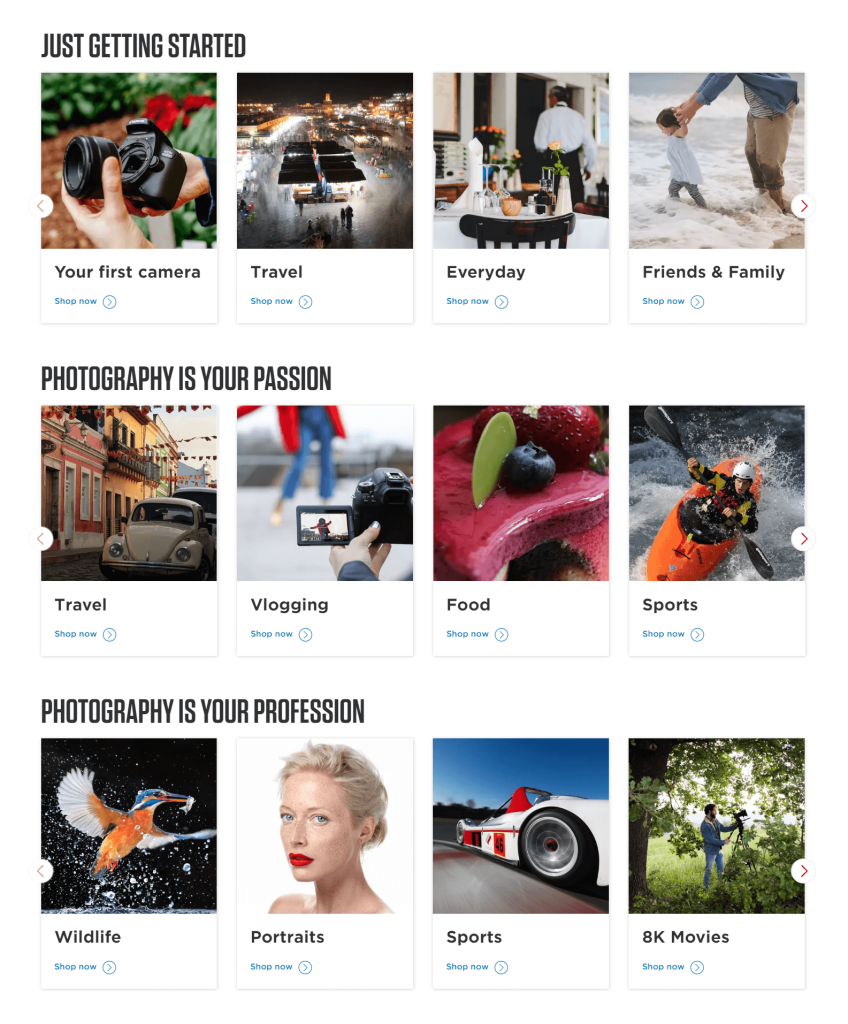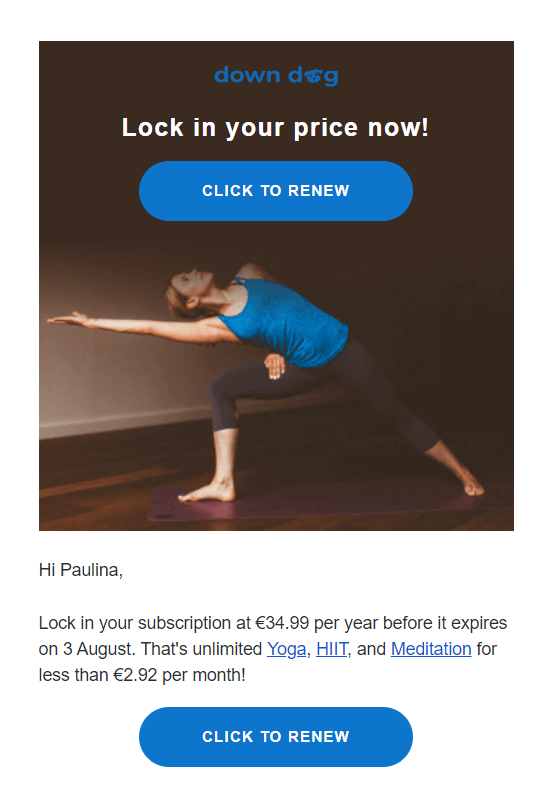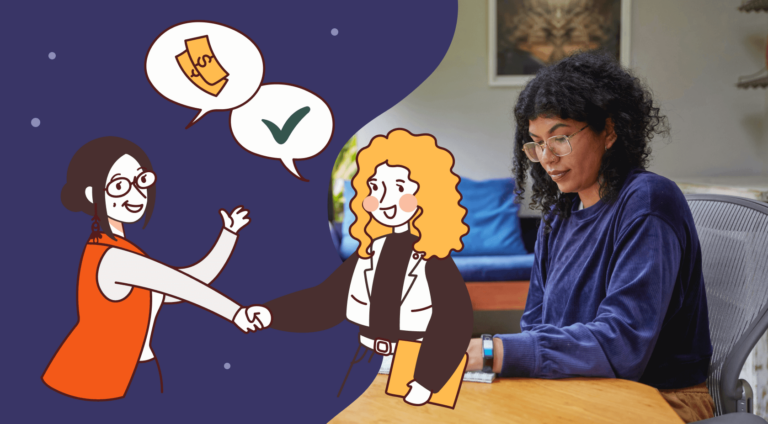Once in a while, it’s good to put yourself in your client’s shoes and understand their point of view. It should be easy enough, because we’re both business owners and consumers on a daily basis — but it’s just as easy to forget that insight. As a result, we make decisions that can alienate potential clients in our quest to increase revenue.
To avoid that, we can create a buyer persona which will help us understand the motivation, needs, and fears of our ideal client. Armed with that knowledge, we can create a purposeful customer acquisition journey that will lead to more conversions and satisfied clients.
Let’s see what kind of customer acquisition efforts will work on Mary in three cases: B2C, B2B, and SaaS.
B2C: Business-to-Consumer
Mary is a young US citizen employed as a junior accountant in a prestigious firm, but she has little interest in the job itself. Her thoughts revolve around photography, her lost love from teenage years. One day, she decides to invest in a proper camera instead of relying on her phone. How will she decide which model to buy?
Awareness
She doesn’t have to wonder about the producer; in the industry, only two names matter, Canon and Nikon. Mary won’t even consider other brands, mostly because she’s not even aware of them. How does she know the previous two? Mostly through word of mouth. These two brands are well established and synonymous with professionalism. They’ve built the unquestioned authority that won’t even budge against lawsuits. Their positions are so strong that if you were to ask Mary, she wouldn’t even have been able to remember any ads or marketing campaigns.
Moreover, Mary doesn’t even have the slightest idea why Canon and Nikon are the best brands. She just knows that all the photographers trust them and keep buying their products, so she didn’t question that.
Consideration
Which brand to choose, Canon or Nikon? Mary might as well just flip a coin. But she decides to read more about these two brands to make a more aware decision.
First, she goes to the websites of these two brands. Canon’s communication is all over the place on the front page, but as she scrolls down, she finds the “Just Getting Started” section with a “Your First Camera” headline. She clicks on it immediately; after all, it’s a message tailored specifically to amateur photographers just like her.
In comparison, Nikon’s website feels a bit overwhelming. There are no helpful categories or content that could guide a hobbyist. She has no idea what’s the difference between Mirrorless, DSLR, and Compact cameras, so she feels a little bit lost. In the end, Mary comes to a conclusion that Nikon caters more to professionals, especially when she sees the prices.
Now that Mary has decided on the brand, she needs to pick a model. Unfortunately, Canon’s beginner section consists of 42 products, which doesn’t make the decision any easier. Instead of going through the products one by one and reading about all the specs she doesn’t have any idea about, she goes to her old friend Google.
She starts off with a search query “best beginner Canon camera”. There, on the first page, she sees several sites she’s familiar with — Expert Photography, Best of Lens, Digital Camera World, and Tech Radar. “If they seem familiar, they must be good,” she thinks. She wouldn’t remember a bad site, after all.
There, she finds lists with different models. She compares the lists, but they hardly help her. Instead, she feels overwhelmed with the amount of new information that keeps complicating the simple act of buying a camera. She decides she can’t think about that right now. She’ll think about that tomorrow.
But tomorrow her boss hands her new, time-consuming responsibilities that take up all of her energy. She shelves her passion for the vague “one day”.
Conversion
She doesn’t think about cameras much anymore, but brands are already on her trail. Those who had remarketing campaigns set properly, now follow her all over the web with their sparkly ads. Is it effective? She personally doesn’t like ads and tries to block them as much as possible, but some do sneak in. She definitely doesn’t click on them, nor does she pay more attention to them than she needs to.
While Mary doesn’t react to those ads as she should have (disclaimer: that’s the marketing team’s opinion), they do make her think of photography from time to time. But they don’t really prompt her to do any action.
Activation
One day, Mary hurriedly walks through the mall, trying to push through the crowds. She’s not in a good mood. Frankly, she feels rather miserable and can’t wait for this day to end.
When she passes next to the electronics store, she notices an ad for a Fujifilm camera that’s currently on sale. After a day like this, Mary definitely deserves an award for dealing with stupid people without resorting to murder — so she goes into the store and buys the camera on an impulse.
Lesson for You
You can polish your customer acquisition funnel as much as you want, but you need to keep in mind that the funnel is a representation of an ideal customer journey. And the truth is, there are hardly any perfect scenarios coming true in the real world. Your potential customers might stumble upon your brand in many different places in a nonlinear way: even though you designed the journey as paid ads-website-remarketing-purchase, someone might go word of mouth-website-newsletter-purchase or be stuck in the circle between the blog and the checkout. Consumers work in truly mysterious ways!
- Brand Awareness. Make sure you know who’s the top dog in your industry. If the brands are already household names, you can’t compete with them without some serious disruption. But you can find a niche that’s left bereft by those giants. And instead of finding (and losing) against them on the search engine optimization (SEO) level, you can beat them in a specific customer acquisition channel of your choice (like Instagram or Pinterest).
- Consideration. You need to know your target audience really well: are they professionals who want to dig into all the technicalities, or amateurs who need guidance and easy choices? Once you know that, it will be easier to acquire customers ready to give your products a shot.
- Conversion. Once you get someone’s attention, you need to bring in the honey to make them stay interested. Depending on the product, people might take a while to make a purchase, so instead, make them stay engaged — by offering them helpful newsletters, free samples, webinars, and so on. And of course, keep reminding them of your offer with the help of remarketing campaigns (which are very effective).
- Activation. Last but not least, the moment we’ve been waiting for — our client makes a purchase. In the case of B2C, the purchase might be just as likely to be a logical result of an in-depth research as triggered by a sweet Black Friday deal or a spectacular breakup. Although it’s ruled by coincidences, you can make those coincidences happen more often by implementing call to actions, discounts, one-kind offers, and other incentives.
SaaS: Software-as-a-Service
One day, Mary decided to finally say goodbye to her 9-5 job and became a freelancer. Her area of expertise — pet photography!
Ever since buying her first camera, our heroine made leaps and bounds in photography, along with more purchases. This time, though, she relied on other professionals’ recommendations, so she bypassed the marketing funnel entirely.
This time, she’s not looking for a product — she’s looking for a software that could help her automate the administrative tasks as much as possible, leaving her more time to do her job. At the moment, she has more clients than she can handle and keeps working overtime, so she’s looking for ways to work less and make more.
Awareness
Contrary to the previous case, here Mary doesn’t know any products. She needs to do some research first. First destination: Google.
There, she searches for “the most useful software for photographers”. This time, she encounters many new sites she’s never heard of before, so she’s a little bit more distrustful. Unfortunately, that’s not exactly what she was looking for — search results revolve mostly around tools such as Adobe or resources like Unsplash.
That’s when she stumbles upon a “HoneyBook”, a client management software for small businesses. The more she reads about it, the more it fits her needs — but she wonders if there are more. So this time, she perfects her search and finds such jewels as Sprout Studio, Studio Ninja or ShootProof, which are tailored-made for photographers, offering such features as mobile portfolios, galleries, and design proofs.
Consideration
Now that Mary is aware of what’s on the market, she needs to make a difficult decision. After all, investing in a SaaS is more terrifying than buying a one-off product — even though the subscription can be canceled anytime, the commitment itself makes people a bit apprehensive.
Thankfully, all the mentioned software offer free trials. Mary can try out all of them herself, but there’s one drawback: the offered trial time of 7 to 14 days isn’t enough to truly test the software in-and-out, at least not without clients and real-life scenarios.
So on top of her own testing, Mary also watches all sorts of videos on YouTube, where professionals like her share tips and tricks on using specific software. They show off their workflows, explain how they work long-term, and make comparisons to other solutions. Thanks to that, Mary can make a much more informed decision.
For example, she knows now which features are necessary to have, the level of automation that’s possible to achieve, and how difficult the software is to set up. Taking all that into consideration, she writes a list of pros and cons, and chooses the software that strikes the perfect balance between ease of use and affordability.
Activation
Now, Mary heads over to the main website of her chosen software and goes directly to the checkout page, choosing the annual payment over the monthly one in order to save some money.
Now, she can start personalizing the software and invite her clients to the new platform. She’s ready to reap all the benefits that were promised!
Awareness
After a year, Mary realizes that she has outgrown the software. The way she does business has changed in the previous year; instead of working for individual clients, who wanted cute photoshoots of their pets, she started long term collaborations with specific kibble brands for more profit. While this change is definitely more profitable, it overthrew all her processes and workflows. Because of that, her current software of choice stopped being enough and Mary is in need of a new software.
Unfortunately, that’s easier said than done. Moving to another platform means starting over; you have to move all your files, configure the software, learn the new features, and explain the switch to the clients. Mary doesn’t have time for that, so she sticks to her current software, even if it no longer fits her.
In her free time, she keeps looking for new solutions, but all of them require time and effort to make them work the way she wants. If she’s ever going to jump ships, it’ll have to be really worth it, so she keeps an eye out for a truly magnificent piece of software. She doesn’t want to waste her time for anything less, after all.
So back to the previous platform it is.
Lesson for You
If you want to create a customer acquisition strategy for your SaaS, you need to keep in mind that you require from your clients’ commitment; because of that, most people won’t make impulsive or even quick purchases. Prepare yourself for a much longer customer journey compared to B2C — it might take several months or even a year before someone settles on you.
Your potential customer will have many doubts and questions about your product. They’ll want to know as much as possible before committing — so make sure that you’re upfront about what you have to offer. Prepare as much content as possible about real use cases, success stories, as well as guides and tutorials, and keep it updated. If you’re wondering whether it’s necessary to explain even the basic things, the answer is yes. What may be obvious to you doesn’t have to be obvious to others.
Another way to dispel any doubts is to offer live demos. Allow people to schedule 1:1 meetings with you where you can explain all the features, answer any questions, and share advice. Some people might be unsure whether your SaaS will fit their business model — be upfront about it and don’t be scared to say “no”. In addition, you’ll be able to gather priceless feedback.
Also, don’t be afraid to make direct comparisons to your competitors, either in the form of long articles or a special landing page full of tables. Your potential users are looking for concise information at a glance, so give them what they need. Just remember: one lie and your whole credibility is shot. Be honest!
Last but not least, it’s a good idea to have a product roadmap on your website, where you can mention any upcoming features, updates, and other incoming changes as far as a year in advance. This way, if someone is missing a vital feature from your SaaS, but sees that it’ll be implemented in a month or two, they might be willing to wait before running to your competitors.
B2B: Business-to-Business
With time, Mary’s business really took off. She’s one of the best pet photographers on the market, and she even has awards to prove it. Her successful collaboration with the famous brands keeps getting her new contracts with very little effort on her part. Because of that, soon she finds herself in a position where she has more clients than she can handle. So she does what she wanted to do for a while now — hire people and build a team!
Now, Mary has a great team of editors and content creators alike who can take many responsibilities off her shoulders. In exchange, she gained some new ones, mostly concerning management, but that’s a story for another time.
Awareness
This time, change is inevitable. Mary is in desperate need of a new software that’s not only tailored-made for photographers, but also supports teamwork and internal communication. Her employees complain about the current processes, calling them chaotic and hard to follow, and Mary agrees with them wholeheartedly. The switch can’t be delayed for much longer.
Unfortunately, all the available options fall short of her expectations (yes, she is picky). So, she decides to look for custom solutions — surely there must be someone who can design everything the way she wants?
Consideration
Mary doesn’t know much about software development outsourcing — she has no idea about the costs, the time needed to make such a software, or even what questions to ask to ensure another company’s credibility.
First, she asks around. As a prosperous business owner, Mary has a big social network, so there are many people she can ask for recommendations. In the result, she hears many different stories, from failed projects abandoned midway to wonderful, yet costly results. When one of her colleagues sings praises to one company, she decides to give them a shot without further consideration.
Activation
Mary contacts the company and quickly gets to business. After a few courteous emails, she jumps onto a call with the sales representative to discuss her project. The sales representative doesn’t seem to be too optimistic — he explains that what she wants isn’t only way over her budget, but it’s also near impossible to develop quickly. Disheartened, she thanks for the meeting and leaves. She judges the company incompetent.
Consideration
Back to the drawing board.
Mary once again puts her trust into Google. By searching for the “The best software development outsourcing company” she stumbles onto Clutch, a B2B Rating & Review site. There, she finds a “Top Custom Software Developers” category and starts browsing.
After a bit of filtering, Mary randomly picks ten companies and emails all of them, asking for quotes.
Activation
Out of ten, only three companies answer her in a prompt manner. When the rest deigns her to reply in the next few days, she’s already deep in the discussion with the previous three.
The first company charges exorbitant fees for their services, so she thanks them politely. The second one outright refused to make such a complex project, while the third one happily took the job without any reservations whatsoever.
Mary thinks she hit the jackpot. She has no idea that a disaster is looming just ahead.
Consideration
Fast-forward to another year, and Mary is at her wits.
The amazing company that promised her everything under the sun turned out to be absolutely horrible. As the time went on, the communication began to crack, with the response time getting longer and longer, and the updates being too vague for her taste. Once she figures out that the company is way over its head and that her project is indeed a tad too ambitious, she ends the partnership.
The whole time, she remembered that one company that outright told her the project is impossible without going on a compromise. She didn’t like that, so she discarded a perfectly fine recommendation. She judged them incompetent, while they actually had the proper experience to make such a bold statement. So with a metaphorical tail tucked between her legs, she contacts the very first company.
Activation
The company isn’t that happy about taking on a messy project that’s midway through, but they agree in the end. During the Discovery Workshop, Mary, along with the design team, reviews what’s been done so far and shapes the new version of the software, eliminating all the nice-to-haves features and focusing on the must-haves instead. The new designs seem promising enough, so Mary agrees to take it further.
This time, her hunch was right. The team made a truly impressive piece of software without crossing over the budget or the deadline. Mary and her team can now enjoy much improved and smoother processes that allow them to focus on what truly matters — scheduling even more photoshoots with the cutest pets.
Lesson for You
Customer journeys in B2B are never as straightforward as in B2C — here, the level of commitment requires more consideration, and coming to a decision might take a while. In bigger companies, B2B gets even more complex, once we add in more people in the decisive role and need to make a group decision (PowerPoint presentations, anyone?).
Also, B2B is dependent on healthy and transparent business relationships that not only spawn glowing recommendations, but also paint you as a true expert in your niche. That’s why you, as a B2B business owner, should go to great lengths to ensure a top-notch customer experience and convert your clients into loyal customers.
Because in B2B clients stay around for longer, it’s good to keep in mind that although the customer acquisition cost might be quite high and cause you anxiety (for example, after seeing Clutch’s prices for getting to the Top 10), the overall customer lifetime value can reward you several times over. So don’t be afraid to start off with discounts and one-time deals that act as a lure or a nice incentive.
Secondly, remember that recommendations and word of mouth reign supreme. That’s why it’s prudent to work on your reputation and credibility. But don’t be passive and wait for other people to leave good reviews by themselves — directly ask for referrals (but only those who are truly happy with you!). In exchange, you can always give something extra to make it worth somebody’s time.
Customer Acquisition Process Done Right: Takeaway
While the customer acquisition processes include marketing funnels, remember that they’re not a 1:1 representation of a client’s journey; it’s an ideal scenario that hardly ever happens in real life. Your target audience will be entering and leaving the funnel many times at many points, and the process might take longer than you think. Don’t count on people being impulsive buyers all the time, naive enough to be swayed by a colorful ad. In many cases, they will deliberate for too long, consult other people, and look for handy comparisons.
If you feel disappointed that your ads, articles, podcasts, and any other form of content don’t bring in direct profit, look at it from another perspective — what you’re doing is spreading awareness and reminding potential buyers of your existence. Maybe at the moment they’re not interested in what you offer, but when the right time strikes, they will remember that quirky little shop that sold custom socks with your pets’ cute little faces (true story).
Don’t get us wrong — it’s not necessarily about conquering all customer acquisition channels. Rather, it’s about being in the right place where your target audience spends the most time.
Then, you need to ensure that you give all the right reasons for people to give you their attention. You can do so by offering them real value: a wonderful newsletter full of the latest news in the industry, a heartfelt podcast that describes past leadership struggles, or in-depth research articles based on true experiences. You can even create a supportive community that helps each other out and share their experiences. This way, your target audience will feel a sense of kinship with you and, more importantly, think of you first when they’ll need similar products or services.
Still, it’s good to give your potential customers a little extra push. Seasonal or holiday sales, locked-in price for SaaS, giveaways and challenges are all good ideas to encourage people to give you a shot (or keep giving you more).
And of course, once your clients are within your grasp, don’t let them go without a fight. Ask them for referrals, reviews, testimonials, or even success stories that could be shared with others. After all, people will always trust other people more than brands, so milk it as much as you can. Also, it’s easier to convince existing clients to make another purchase (or sign up for another year of subscription) than to convince a new person, so make sure your marketing strategy is geared towards spoiling them.
If you don’t know how to do that or have too many doubts and ideas, flip your perspective by jumping right into your client’s shoes. That’s where you’ll find the best answers yet.

A free online training. Delivered daily to your inbox to grow your productized agency.















